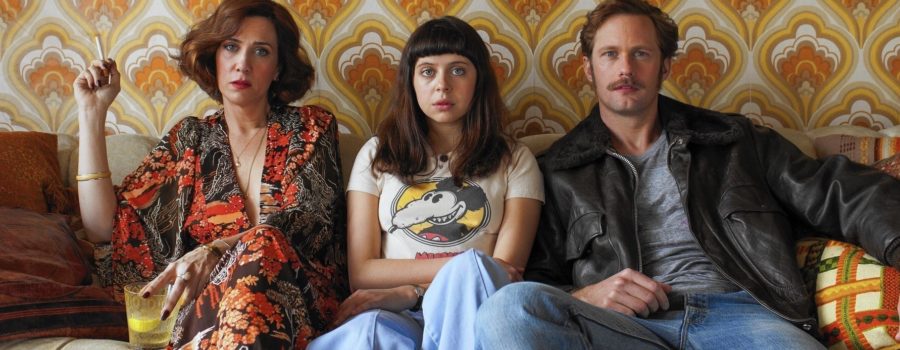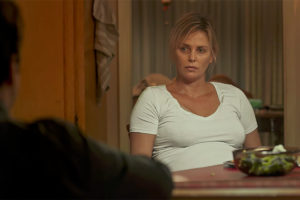This review of “The Diary of a Teenage Girl” will unfold more as a stream of consciousness. “Diary” was written by Phoebe Gloeckner, who published this autobiographical story as a graphic novel. I have not read it yet. The film was adapted by Marielle Heller. Refreshingly, “Diary” has sweeping, elegant shots of some of San Francisco’s lesser known views, perspectives, and sceneries. Heller did a nice job of taking the viewer back to a specific time in the city; the period is the 1970s, arguably one of the most pivotal times in San Francisco history. The lingering after-effects of the hippie movement, free love, and an important time for gay rights advocacy are subconsciously, simultaneously embraced and ignored by Minnie (played brilliantly by Bel Powley), a 15-year-old virgin. Minnie navigates her way through a sexual awakening that is equal parts shocking and uncompromising; it is portrayed with such brutal honesty and without judgment. Every adult has gone through some sort of transition from relatively innocent child to a sexually aware being. Some of these transitions take years, some take far less. In this case, it happened to our main character in one summer.
There is nothing wrong with discovering our bodies and those of others, but this is one of the most disturbing coming-of-age stories I’ve ever witnessed. Though tastefully made and well-written, one cannot help but cringe at certain moments. As aforementioned, Minnie is only 15 years old. She has her first sexual encounter with her mother’s (played with fine nuance by the ever-expanding Kristin Wiig) degenerate boyfriend, Monroe (played indifferently by the stone-faced Alexander Skaarsgaard), who is over twice her age. Skarsgaard has gotten by in the film industry largely based on looks and family name alone; his father, Stellan, is exponentially more talented, and a true thespian. You’re probably wondering why I just casually mulled over describing statutory rape. That’s because the writer did just this. Never once is it portrayed as wrong, sick, or inappropriate, although, perhaps to Heller’a credit, Minnie wouldn’t understand that it is necessarily wrong given her young age, time period, and setting. Herein, nonetheless, lies the first problem in this story: a 15 year old girl was raped by her mother’s boyfriend, having not had the mental tools equipped enough to make her own informed decision. She felt that she wanted it. She had no idea what she wanted. Ultimately, it ended up hurting her and those around her. As for Monroe, it goes without saying that he should have been incarcerated. I suppose people got away with a lot more back then.
Throughout her various sexual exploits, induced by alcohol, drugs, and copious amounts of misplaced desire, Minnie spirals out of control and loses some dignity in the process. In one scene, she even partakes in a group blowjob with two other men while her and one of her female friends hold hands, though afterwards, both of them immediately regretted the act. As I mentioned earlier, Minnie is, more or less Gloeckner. I do admire her courage in telling this unflinching story of a sexual awakening at the tail-end of San Francisco’s glory days, because it his her story. Her character, though, however much of a variation it is from her actual teenage self, never undergoes a large enough change (albeit a significant emotional arc) within the confines of the film to engage the viewer. She is mundane, though extremely precocious. She puts continuous blame on other people, including her mom, and uses them as a rationalization for her acts. She is not our typical protagonist.
One might view this poor girl’s plight as female empowerment, although it is not trying to strive for that deep of a message. It is simply an unflinching portrayal of a promiscuous teenage girl having sex with whoever she wants at whatever cost to her and those around her. Teenagers can be difficult and unaware, but some are worse than others. Obviously men and women should do as they please with their bodies, but at a certain point, that idea can cross the threshold of self-respect (i.e. their bodies being unwittingly taken advantage of) and into the realm of physical and emotional damage. Though, respecting one’s body is easier said than done, particularly for a somrbody with an abnormal childhood going through puberty during a transitional time period in San Francisco history.
Remember when I mentioned free love and hippies? That encapsulated San Francisco in the 1960s, and the aftershock (pun intended) of that phenomenon still affected the city in the 1970s. Minnie was also a product of her surrounding culture. Her mother was uncaring and uninvolved, not ever allowing her to see the error in her actions, not ever being engaged enough to even know what was happening with her daughter. Wiig deserves immense credit for showing her dramatic chops with as much effectiveness as those of her comedic turns.
This story, apart from having a rather boring central character, is told by somebody who no doubt has a unique way of looking at the world. Heller had such an opportunity to parallel what was going on with Minnie’s life to the important sociocultural events happening around her, as I just did with the hippie movement. Instead, she focuses on Patty Hearst (this was not in the original graphic novel, as I understand), and makes a feeble attempt at drawing connections between Ms. Hearst and her kidnappers and Monroe and Minnie’s relationship. The likeness is a stretch. She could have even contrasted her life with certain sociocultural movements in San Francisco, namely Harvey Milk’s extraordinary rise to power; his sincere dignity and struggle to prove that he had the right love whoever he wanted to would have been a welcome antithesis to our antihero, who had no regard for the value love, simply because she did not know what love was. It was a selfish, squeamish quest of physical stimulation packed into 102 minutes.
The blend of animation is not effective in providing a glimpse into Minnie’s imagination; Heller could have used Gloeckner’s graphic novel more wholly to illustrate Minnie’s personality. Instead, it seems Heller has attempted and failed to do what writer and director Jonathan Levine did with his debut, “The Wackness”, which was a much more honest (and appropriate) look at growing up. Levine utilized its New York settings well to combine animation, graffiti, and live shots that gleefully come together to express an earnest mind of a teenager in transition to adulthood.
Though widely regarded as a great film by critics due to its honesty, I do not believe that Minnie’s story is the everywoman’s journey, although that is not to say it is a boring one. It is an uncomfortably fascinating look into a trouble child’s coming-of-age. I believe this film has merit in its wonderful shots of San Francisco (from the breathtaking Aquatic Cove to the welcome dirtiness of Haight-Ashbury) to its knockout performances in Kristin Wiig and relative newcomer Bel Powley. Powley understands Gloeckner’s Minnie, and immerses herself into the role so well that it leaves viewers both unsettled and astounded. However flawed this film may be in certain aspects, it is a commendable effort for newcomer Marielle Heller, and it will be a pleasure to see her evolve as a filmmaker in the future.







Leave a Reply
Your email is safe with us.